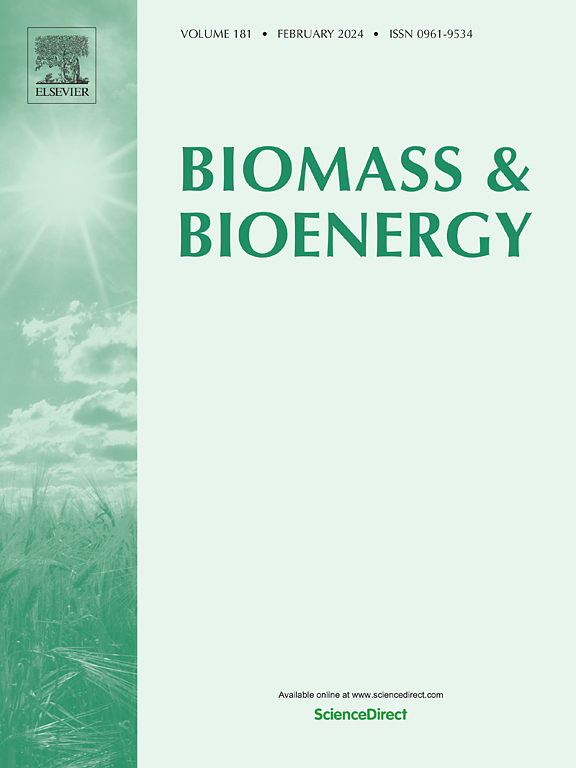在碳纳米管支撑的镍-钼和钴-钼上对废食用油进行水处理以生产液体燃料
IF 5.8
2区 生物学
Q1 AGRICULTURAL ENGINEERING
引用次数: 0
摘要
为了替代化石能源,减少碳排放对环境的影响,越来越需要新的燃料生产替代品。在这种情况下,废食用油(WCO)等可再生资源是生产生物基燃料的绝佳选择。然而,要将 WCO 用作燃料,必须去除其甘油三酯结构中的氧含量。为此,研究人员合成了支撑在原始碳纳米管(CNT)和氧化碳纳米管(CNTox)上的双金属 Co-Mo 和 Ni-Mo,以研究在 350 °C、70 bar H2(在环境温度下评估)下运行 3 小时的间歇式反应器中对 WCO 的加氢处理。结果表明,Ni-Mo/CNTox 表现出卓越的催化性能,主要生产 C14-C22 范围内的正构烷烃,碳转化率约为 67 摩尔%,并对轻质烷烃(6.6 摩尔%的 C5-C7)、喷气燃料(11.4 摩尔%的 C8-C16)和柴油(81.2 摩尔%的 C17-C22)具有选择性。另一方面,碳支撑 Co-Mo 催化剂需要 5 小时的停留时间才能达到相同的效果。氢脱氧是使用 CNT 催化剂的主要脱氧途径。本文章由计算机程序翻译,如有差异,请以英文原文为准。
Hydroprocessing of waste cooking oil to produce liquid fuels over Ni-Mo and Co-Mo supported on carbon nanotubes
New fuel production alternatives are becoming increasingly necessary to replace fossil energy sources and reduce the environmental implications of carbon emissions. In this context, renewable sources, such as waste cooking oil (WCO), are an excellent choice for producing bio-based fuels. However, to use WCO as fuel, the oxygen content in its triglyceride structures must be removed. To this end, bimetallic Co-Mo and Ni-Mo supported on pristine carbon nanotubes (CNT) and oxidized carbon nanotubes (CNTox) were synthesized to investigate the hydroprocessing of WCO in a batch reactor operating at 350 °C, 70 bar of H2 (evaluated at ambient temperature) for 3 h. The results showed that Ni-Mo/CNTox exhibited superior catalytic performance, mainly producing n-alkanes in the range of C14-C22 with a carbon conversion of about 67 mol.% and being selective for light alkanes (6.6 mol.% of C5-C7), jet fuel (11.4 mol.% of C8-C16) and diesel fuel (81.2 mol.% of C17-C22). On the other hand, a residence time of 5 h was necessary to achieve the same results with the carbon-supported Co-Mo catalysts. Hydrodeoxygenation was the main deoxygenation route followed using CNT based catalysts.
求助全文
通过发布文献求助,成功后即可免费获取论文全文。
去求助
来源期刊

Biomass & Bioenergy
工程技术-能源与燃料
CiteScore
11.50
自引率
3.30%
发文量
258
审稿时长
60 days
期刊介绍:
Biomass & Bioenergy is an international journal publishing original research papers and short communications, review articles and case studies on biological resources, chemical and biological processes, and biomass products for new renewable sources of energy and materials.
The scope of the journal extends to the environmental, management and economic aspects of biomass and bioenergy.
Key areas covered by the journal:
• Biomass: sources, energy crop production processes, genetic improvements, composition. Please note that research on these biomass subjects must be linked directly to bioenergy generation.
• Biological Residues: residues/rests from agricultural production, forestry and plantations (palm, sugar etc), processing industries, and municipal sources (MSW). Papers on the use of biomass residues through innovative processes/technological novelty and/or consideration of feedstock/system sustainability (or unsustainability) are welcomed. However waste treatment processes and pollution control or mitigation which are only tangentially related to bioenergy are not in the scope of the journal, as they are more suited to publications in the environmental arena. Papers that describe conventional waste streams (ie well described in existing literature) that do not empirically address ''new'' added value from the process are not suitable for submission to the journal.
• Bioenergy Processes: fermentations, thermochemical conversions, liquid and gaseous fuels, and petrochemical substitutes
• Bioenergy Utilization: direct combustion, gasification, electricity production, chemical processes, and by-product remediation
• Biomass and the Environment: carbon cycle, the net energy efficiency of bioenergy systems, assessment of sustainability, and biodiversity issues.
 求助内容:
求助内容: 应助结果提醒方式:
应助结果提醒方式:


